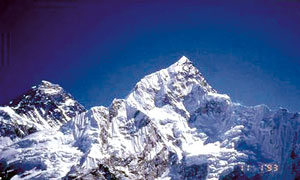 |
Everest summit fever is raging dangerously. From the second week in May to the first week in June, climbers who have taken about six to eight weeks to acclimatise at high altitude are now attempting to scale the summit. However this has been a very hostile season with an "active" icefall and the precarious rock-fall ridden Lhotse face which the climbers have to pass by. Noting the dangersthis season, well-respected mountain guide, Russell Brice, has recently abandoned attempting to put any of his sixty clients on the summit. Perhaps others planning to climb Everest need to take note.
Indeed just this weekend, three climbers have died and two are missing. The problems this season are two-fold. The first problem, crowded conditions, is an old issue. The second problem has been excessively dry weather conditions leading to more rock falls in the Lhotse-face area. The congestion in the mountain probably enhances the chances of rock falls and avalanches. In addition, weather conditions have been so poor near the summit that it will encourage a climbers' stampede when there is a window period of good weather.
Furthermore, climbers are so determined to reach the top that they forget about the "turnaround time". Because descent in the dark from the summit of Everest can be more treacherous than the ascent, climbers are cautioned to turn around and not go for the summit after 11 am. But some of the climbers last weekend were heading for the summit even at 2:30 pm.
Many of these climbers at altitudes near 8,000m try to save up on their supplemental oxygen to use it for the final summit bid. With long waits and devoid of adequate supplemental oxygen at such altitudes, the vital organs of the body are compromised setting the stage for tragedy to unfold.
Clearly there are a multitude of factors that may influence a successful ascent on Everest. Travel and trekking companies need to raise the level of awareness in their clients of the potential medical (and other) dangers of attempting to climb the world's highest peak and other 8000m peaks as many of these new climbers are just novices without a notion of what goes on up there. This awareness campaign may seem counterproductive for business; but just like Russell Brice, if you have a reputation for safety first, it may actually help business. Perhaps the Nepali government could also consider decreasing congestion and avoiding tragedy while climbing Everest by limiting the number of climbers.


